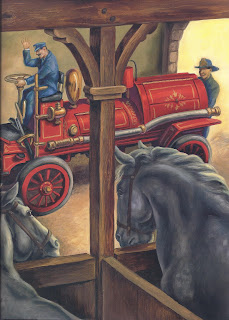The diminutive Small with the prominent nose is back. This
time, however, instead of being a firefighter, he is a trench coat wearing,
Vespa riding, ace detective. Overnight all of the bananas in town are
stolen. The police are stumped so Detective Small is contacted. Combing the
scene of the crime, he finds strands of hair, a
foot print and a swatch of fabric snagged on a nail. Afterwords, Detective Small returns to his office to study
the gathered clues.
The hairs were not from a cat or a dog;The print was too big for a cow or hog;
The cloth dyed yellow was some type of tweed . . .
WHO could’ve pulled such a dastardly deed?
WHO could’ve pulled such a dastardly deed?
He ponders over the details of the crime and wonders why bananas, as opposed to other types of fruit, were stolen. He decides that the culprit is . . . an APE.
Small, investigates around town,
sniffing around for the scent of bananas and questioning people. Fulsome Fox,
an ice cream shop owner, provides Detective Small with a lead: a
suspicious looking ape has been hanging around the docks. Small visits the
docks and spots the gorilla. A hilarious pursuit on foot begins -- over train tracks,
atop a building, across phone wires, through a tunnel and down a ladder. When he is cornered, the gorilla surrenders.


Once arrested, an inspection of the the gorilla's clothes reveals no holes, and there is no match with his shoe print and the print found at the crime scene. Furthermore, a search of the gorilla's boat does not uncover any evidence. Things do
not add up, and Small begins to doubt that he has the right suspect.
Through further detective work, Small determines that the gorilla has been framed and he uncovers the identity of the true culprit. The banana stealing, gorilla framing criminal is . . ..
My eldest son was crazy over Fireman Small by Wong Herbert Yee when he was younger. Once he turned 4 he began to prefer Detective Small in the Amazing Banana Caper because of it's more complex plot which will appeal to slightly older kids. My baby girl still loves Fireman Small.
My eldest son was crazy over Fireman Small by Wong Herbert Yee when he was younger. Once he turned 4 he began to prefer Detective Small in the Amazing Banana Caper because of it's more complex plot which will appeal to slightly older kids. My baby girl still loves Fireman Small.



















































